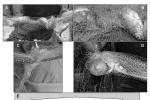Eel attacks-A new tool for assessing European eel (Anguilla anguilla) abundance and distribution patterns with gillnet sampling
Because of its complex life cycle, cryptic behavior, body shape, ability to excrete mucus and excellent maneuvering, the European eel (Anguilla anguilla) is difficult to monitor. For example, in gillnets eels represent the most unusual catch, together with water birds, game, frogs and semiaquatic snakes. During many years of gillnetting in Dutch and Czech freshwaters, we registered characteristic involutions of gillnet netting with a partially eaten fish inside. We concluded that these involutions were the result of eels attacking fish caught in gillnets and called the occurrences eel attacks. Eel belong to species that are not able to separate a bite out of bigger prey using teeth, thus they use rotational feeding instead. They grasp prey and spins rapidly around their long axis, thus tearing pieces of the prey that can be swallowed. Rotational feeding has been described in all eel species as well as in other 20 fish species, amphibian with snake-form body and crocodiles.
When we compared the abundance of eel attacks in gillnets with the abundances of eels recorded using active gears (beach seining and trawling), we found a positive and significant correlation (partial Spearman R = 0.640) that can be used for rough eel-abundance assessment. The most frequently attacked fishes were young individuals of abundant species (Perca fluviatilis, Sander lucioperca, Rutilus rutilus and Osmerus eperlanus) and small species (Gymnocephalus cernua) up to 100mm standard length. The eels preferred pikeperch and avoided roach and smelt. The reason for prey species preferences was most likely prey species distribution rather than size selectivity. The eels attacked fishes in gillnets during the night, most likely after midnight. The eel attacks were not distributed homogenously among the studied reservoirs, geographical areas and years. The frequency of eel attacks was higher in benthic than in pelagic habitats. Eel attacks were more frequent in Dutch than in Czech reservoirs, corresponding to a general decline of eel densities with increasing distance from the sea. The number of eel attacks also declined significantly from 1998 to 2008, which agrees with the general decline of eel stocks in Europe. There are likely many reasons for this decline, and the most cited reasons are overexploitation, seaward-migration barriers, changes in oceanographic conditions, habitat loss and contamination, decreased production of the glass eel, infestation with the swim-bladder nematode Anguillicola crassus, predation by cormorants, poor-quality spawners, relocations of glass eel, and reductions of available prey caused by the reoligotrophication of freshwater habitats. Accordingly, eels were classified as a critically endangered species in the IUCN Red List.
The present study showed that eel attacks can be successfully used as a new, simple and nonintrusive tool for monitoring eel abundance using gillnets. Gillnets are widely used in fish monitoring, and hence, gillnet sampling performed throughout Europe has a great potential for eel-abundance assessment.
Research outputs:
Prchalová, M., Kubečka, J., Říha, M., Čech, M., Jůza, T., Ketelaars, H.A.M., Kratochvíl, M., Mrkvička, T., Peterka, J., Vašek, M., Wagenvoort, A.J., 2013. Eel attacks - A new tool for assessing European eel (Anguilla anguilla) abundance and distribution patterns with gillnet sampling. Limnologica 43, 194-202. doi:http://dx.doi.org/10.1016/j.limno.2012.09.003















